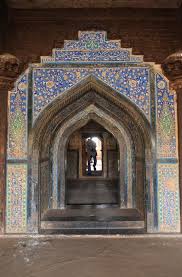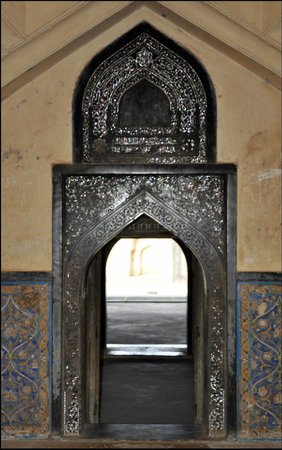Rangin Mahal means the ‘Colored Palace’, and this name was apparently given to it because its walls were originally decorated with tiles of different hues, traces of which still exist on the facade of the eastern halls . Near the Gumbad Darwaza a royal tower has existed perhaps since Ahmad Shah Wall built the fort (a.d. 1429-32). From this tower, which is mentioned as the Shah Burj in contemporary history, the Bahmanl kings often reviewed their troops, which assembled outside the fort's gate. In 892 h. (a.d. 1487) when a party of Abyssinians and Deccanis revolted against Mahmud Shah Bahmanl and tried to murder him, he took refuge in the Shah Burj. The rebels were subsequently punished, but as the king had despaired of his life he considered the shelter afforded by the Shah Burj as auspicious, and he had a lofty palace built in its close vicinity. The southern apartments of this palace were rebuilt by 'Ali Barid (a.d. 1542-80), who adorned them with wood-carving and mother-of-pearl work.
Rangin Mahal means the ‘Colored Palace’, and this name was apparently given to it because its walls were originally decorated with tiles of different hues, traces of which still exist on the facade of the eastern halls . Near the Gumbad Darwaza a royal tower has existed perhaps since Ahmad Shah Wall built the fort (a.d. 1429-32). From this tower, which is mentioned as the Shah Burj in contemporary history, the Bahmanl kings often reviewed their troops, which assembled outside the fort's gate. In 892 h. (a.d. 1487) when a party of Abyssinians and Deccanis revolted against Mahmud Shah Bahmanl and tried to murder him, he took refuge in the Shah Burj. The rebels were subsequently punished, but as the king had despaired of his life he considered the shelter afforded by the Shah Burj as auspicious, and he had a lofty palace built in its close vicinity. The southern apartments of this palace were rebuilt by 'Ali Barid (a.d. 1542-80), who adorned them with wood-carving and mother-of-pearl work.

